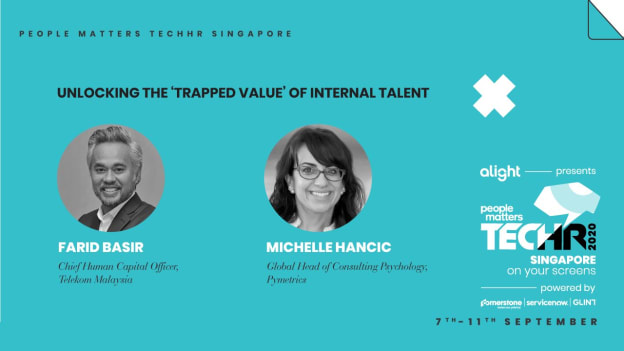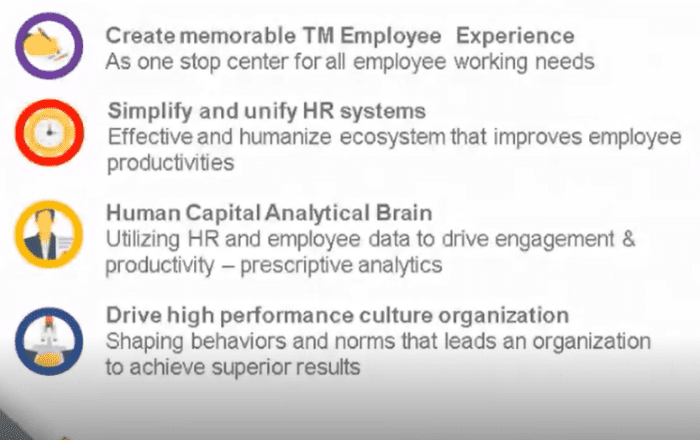Unlocking the trapped value of internal talent

Michelle Hancic, Global Head of Consulting Psychology for pymetrics, is a psychologist passionate about internal mobility and an expert in the importance of helping people find jobs they’re truly motivated to fulfill. Today, Michelle works with clients to address talent acquisition needs through tech, such as pymetrics. Speaking at TechHR 2020, Michelle gave an insight into how pymetrics are using technology and data-driven insights to leverage capabilities and help professionals thrive and grow in their careers.
Three Key Components
“If we want more success for ourselves, our employees, and our organization, we need to really develop a holistic understanding of the individual and their alignment to their jobs or career experiences they’re best suited to,” Michelle says. “To achieve this we really need to understand three key components of job fit.”
These are:
Technical Skills
Behaviors & Soft Skills
Motivation
How do we start to test for and track these components?
Are you seeing the whole person or just the tip of the iceberg?
Michelle uses the Iceberg Model to expand on the importance of building a holistic understanding of a person when it comes to their careers. “Many internal mobility programs and technology platforms do rely on what is easy in the technical skills,” Michelle says. “But that’s only 10% of the picture.” Sitting below the surface, our behaviors & soft skills, as well as our motivations, make up 90% of what’s crucial to job success. In addition, Michelle says, “they’re harder to understand and assess for.”
pymetrics Talent Marketplace
Using data-driven insights, pymetrics help companies better understand their workforce and redeploy people effectively to further their careers.
“Our marketplace allows organizations to assess people across soft skills through gamified exercises that we use. We also bring in technical skill data and capture motivational information via our digital interview platform.”
By gathering all this information, pymetrics are also able to determine what personalized learning & development systems might be needed for individuals. Not only does this identify where an individual currently stands skills and motivations-wise, but allows for gaps to be determined and filled as well.
Career Experiences
Discussing how our approach to career paths has changed, Michelle quoted Marina Yabor, Talent Director Latin America, Kimberly Clark:
“Today’s generation is demanding a different approach to thinking about their careers. We can’t continue working with traditional career paths. We need to move to another approach more related to experiences.”
What does this mean for the team at pymetrics? “We’re really enabling a data-driven way of looking at career mobility which also challenges our preconceived notions of where internal candidates will come from. The classic linear and upwardly mobile career paths are a thing of the past,” says Michelle. “Talent can come from anywhere in the organization.”
Old mindsets persist around talent acquisition but by using data-driven insights, pymetrics can challenge these ways of thinking, boost transparency, empower people to move great-fit, rewarding roles within their organization and ultimately stay motivated throughout their career experience.
“Now we have the technology to enable even better and faster matching at scale, but the human impact is still the same: meaningful work that leverages our capabilities and motivations enabling us to be fulfilled and thrive at work,” Michelle says.
We have to think inside the box, not think outside the box
With over 32,000 people in their talent ecosystem, Telekom Malaysia employs a diverse suite of leaders, executives, permanent roles, and contingent workers. So, how are Telekom Malaysia using tech solutions to enhance talent mobility?
“All of us as HR professionals, we know that talent mobility is one of the most powerful forces for agile transformation,” Farid Basir, Chief Human Capital Officer at Telekom Malaysia, said. What are the key considerations for talent mobility?
- How to unlock it?
- How to scale it?
- What role technology can play?
- What else is needed?
The ERA App
One of the key ways in which Telekom Malaysia are improving the employee experience is through their ERA app. Developed in-house, the app is a “one-stop center for all employee needs” that uses data to boost engagement and productivity.
“The challenge that we have in the HR system, usually when we design it, people have the tendency to automate the current process rather than re-engineer and improvise based on the capability of the technology,” Basir says. That’s where ERA steps in. Here are the main objectives and purposes of the app:

According to Basir, The ERA app has shaped talent structures at Telekom Malaysia in three key areas:
Enables Internal Talent Mobility
“We need to engage and retain internal talent with the best internal mobility features offered by the in-house app,” Basir says. “These features in ERA allow us to effortlessly advertise internal jobs in one place with integrated internal profiles that improve job search functionalities as well as employee-specific screening questions.”
“This is when we have to think inside the box,” Basir says. “Not think outside the box.”
Enables career conversations that resulted in individual development plans
“As an organization, it is our responsibility to cultivate a workforce that is curious, eager to learn, strives for expanding horizons,” says Basir. “The best way to do this is through line managers having career conversations with their people.”
The ERA app has a feature that enables setting up career conversations to be as simple and powerful as possible. Tech has helped to foster these conversations, leading to practical, tangible benefits for employees through development plans.
The results of this ERA feature have been striking, with 32,445 development plans identified through conversations facilitated by ERA:
Enable people managers to conduct talent classification to facilitate focused and differentiated development plans.
Thirdly, by employing the widely-used nine-box model metric tool, the Telekom Malaysia team is able to use ERA to track different levels of potential and sustained performance to classify talent, thus enabling better-designed development plans. “The idea behind the talent metric is that by defining how each employee fits in the grid, we can better understand where each employee stands and how they should be positioned in our future organizational shift,” says Basir.
Most notably of all, the ERA app was implemented and began bringing in great results in a matter of months. A truly agile way of working with tech to make life easier for Telekom Malaysia’s people, the ERA App is a fascinating portal and centralized, in-house resource for maximizing talent mobility.
















